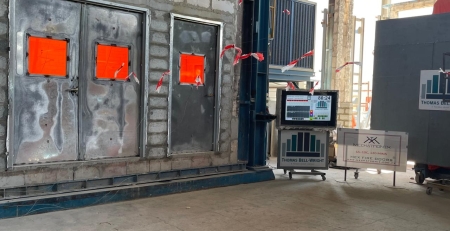A Complete Look Inside The Structure of Fire Rated Door!
A fire door is a crucial lifesaving commodity, but its effectiveness relies on its composition. At its core, door’s frame is hollow, filled with fire-resistant materials that provide its strength. To enhance its durability and resistance, specialized equipment and fire retardant materials are used. Let’s delve into the details of these substance and door types, exploring what makes a door truly fire resilient.
What Does Fire Rated Door Made Up Of?
Fire-rated doors are typically constructed from a variety of materials, including timber, glass, galvanized steel, metal (such as mild steel and stainless steel), aluminum, and PVC. In Pakistan, however, the most commonly available options are wood and metal doors, which are often certified to international standards such as UL (Underwriters Laboratories) and BS (British Standards) by multiple manufacturers.
Wooden Doors:
You might doubt that how a wood can stop fire, as it catches more. But it’s not for all kind of woods. It can save lives of many. You just need a proper installation and best production. There are two types of wooden doors, full wooden door and in filled door.
Full wooden doors vs. In-filled wooden doors:
Wooden fire doors are made of wood or composite materials with fire-resistant fillers like gypsum, treated with resistant chemicals. They’re designed to resist blaze and smoke, with a traditional and natural look.
However, In-filled Fire doors have a wooden frame filled with resistant materials like rock wool or gypsum, making them lighter and cost-effective compared to solid wood doors. They’re ideal for areas where aesthetics matter, matching the look of other wooden doors.

A standard fire wood door is made up 510kg that stands for 60 minutes, whereas, 650kg/m3 door stands for 90-120 minutes. Most people probably wouldn’t consider wooden door as fire resistant but many fire rated doors are made using timber that actually save lives.
Metal Doors:
Steel doors are most of the time popular choice for many. As it is non combustible material, and will not induce fire. Most people prefer using them because of cost-effectiveness. It also comes with high rating starting from 30-120 minutes.
Same as wooden doors, metal doors also available in two types

Mild Steel Door vs. Stainless steel Door
Mild steel fire doors have durable RAL-painted steel, and GI sheet is used to prevent it from rust. While the inside is hollow core. The core is filled with various materials for fire protection, insulation, and soundproofing. You may customize door with additional features, such as lead lining for X-ray shielding or reinforcement for ballistic resistance.
Whereas, stainless steel doors offer high corrosion resistance and a polished appearance that improves over time. Fire ratings vary depending on the internal materials used. They may lack aesthetic appeal due to limited ductility. Stainless steel doors excel in durability and strength due to their corrosion-resistant properties.
What’s inside the fire rated door?
There is a combination of materials is used to construct fire rated doors, including Rockwool, Honeycomb paper, Magnesium board, Thermocol, Perlite core filling, cement board with Polyurethane, and fireproof MDF. Each material plays a crucial role in making the door strong, sturdy, and resistant to fire. Let’s explore the details of these components.
Rockwool
Rockwool insulation limits fire up to 1,000°C made from natural or synthetic fibers. It provides thermal insulation, reducing heat transfer, and slowing down fire spread. It also fills the door’s cavity, enhancing its fire rating and ensuring compliance with safety standards.
Honeycomb Paper/Sheet
Another lightweight yet 100% durable recycle material used is Honeycomb paper made up of polypropylene. Its unique structure traps air, reducing heat transfer and slowing fire spread easily. The material used in the composition of the honeycomb is a flame retardant, without halogen.

Magnesium board
Magnesium oxide isnon-combustible materialmake a perfect Magnesium board. It serves as a core or sheathing material, providing exceptional fire protection, durability, and stability. Its high melting point and non-combustible properties help maintain the door’s integrity during fire exposure, ensuring a secure barrier.
Thermocol
In fire doors, Thermocol sheets are often treated with fire-retardant chemicals or coated with Intumescent materials that expand when exposed to heat. It creates a barrier that insulates and protects the door’s core.
When fire door is exposed to heat, its inside material expands and forms a hard, inorganic barrier that prevents fire spread. It happens due to Perlite core filling. The water content in perlite (4-5%) releases steam, cooling the surrounding area, while its unique structure prevents flames from propagating. This potent combination ensures that fire doors maintain their integrity, safeguarding against fire risks.

A fire door’s core is protected by a composite material that provides exceptional fire resistance. This is achieved through a combination of a non-combustible cement board base and a polyurethane coating that expands when exposed to heat, forming a protective char layer.
MDF Panels
Fire proof MDF panels are another major flame-resistant product. They are treated with fire-inhibiting chemicals to achieve a Euro class C fire rating, making them an excellent choice for applications where safety standards must be met.
The choice of materials determines a door’s resistance duration. Customers can tailor their door’s specifications by selecting or omitting various components to meet their specific needs. If you want to have best fire-rated in Pakistan, you may contact us. For any assistance or customization options, please don’t hesitate to reach!










